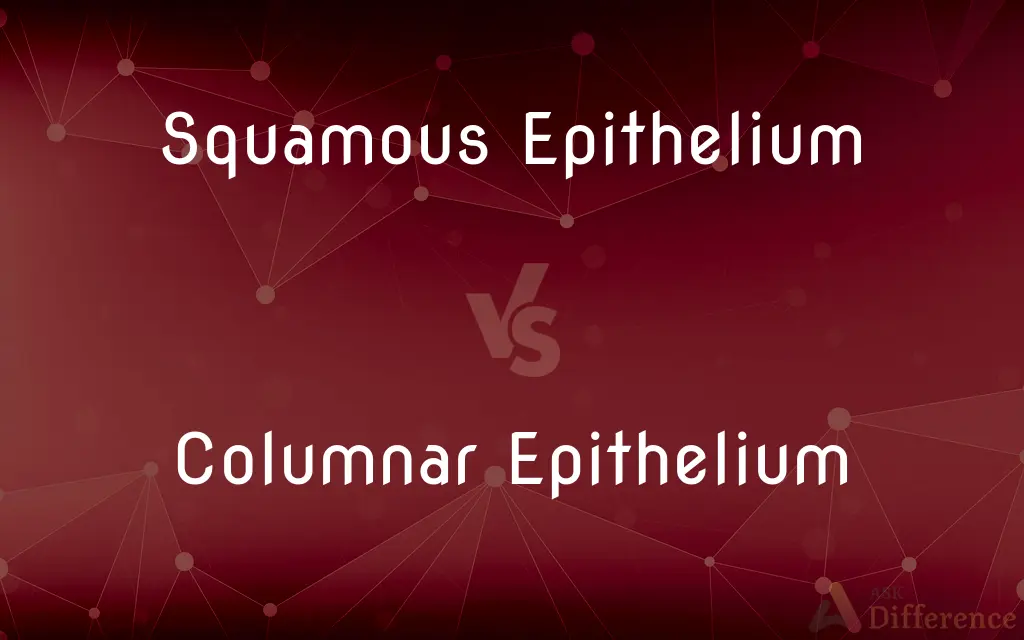Squamous Epithelium vs. Columnar Epithelium — What's the Difference?
By Tayyaba Rehman — Published on January 13, 2024
Squamous epithelium consists of flat, scale-like cells, providing a protective layer, often found in skin. Columnar epithelium, composed of tall, column-like cells, lines internal body surfaces, involved in absorption and secretion.

Difference Between Squamous Epithelium and Columnar Epithelium
Table of Contents
ADVERTISEMENT
Key Differences
Squamous epithelium cells are thin, flat, and tightly packed, creating a smooth, low-friction surface ideal for areas requiring protection, like skin and blood vessel linings. Columnar epithelium cells are taller, resembling columns, and are found in areas where absorption and secretion occur, such as the lining of the gastrointestinal tract.
The squamous epithelium provides a barrier against pathogens, and its flat nature allows for rapid diffusion of substances. Columnar epithelium, with its taller cell structure, is equipped with microvilli or cilia on the surface, enhancing its absorptive and secretory functions.
Squamous epithelial cells are often found in layers (stratified) for added protection, as in the skin, or in a single layer (simple) in blood vessels. Columnar epithelium is typically found in a single layer, allowing for efficient nutrient absorption in the intestines.
The squamous epithelium is adapted for areas exposed to physical or environmental stress, providing durability. Columnar epithelium is specialized for the internal environment, playing a key role in the body's nutrient processing and waste elimination.
In terms of regenerative capacity, squamous epithelium, especially in the skin, has a high turnover rate to replace damaged cells. Columnar epithelium also regenerates, but its primary function is less about protection and more about maintaining internal body processes.
ADVERTISEMENT
Comparison Chart
Cell Shape
Flat, scale-like cells.
Tall, column-like cells.
Location
Skin, blood vessels, respiratory tract.
Stomach, intestines, respiratory tract.
Function
Protection, diffusion.
Absorption, secretion.
Surface Adaptations
Smooth for minimal friction.
Microvilli or cilia for increased surface area.
Regeneration
High turnover for damage replacement.
Regular turnover for functional maintenance.
Compare with Definitions
Squamous Epithelium
Can be stratified for extra protection in areas like the skin.
Stratified squamous epithelium in the epidermis guards against physical damage.
Columnar Epithelium
Columnar epithelium consists of tall, cylindrical cells, specialized in absorption and secretion.
The columnar epithelium of the intestines maximizes nutrient absorption.
Squamous Epithelium
Squamous cells are tightly packed to form a barrier against infection.
The skin's squamous epithelium protects against external pathogens.
Columnar Epithelium
Can be ciliated in areas like the respiratory tract for moving substances.
Ciliated columnar epithelium in the trachea helps trap and expel contaminants.
Squamous Epithelium
Squamous epithelium is composed of flat, plate-like cells forming protective layers.
The squamous epithelium in the alveoli allows for efficient gas exchange.
Columnar Epithelium
Often features microvilli for increased surface area.
In the small intestine, the columnar epithelium's microvilli enhance digestion efficiency.
Squamous Epithelium
It lines organs where rapid diffusion is necessary.
In blood vessels, the squamous epithelium facilitates smooth blood flow.
Columnar Epithelium
It provides a protective lining in the respiratory and reproductive tracts.
Columnar epithelium in the bronchi protects while aiding in mucous secretion.
Squamous Epithelium
It is involved in absorption and filtration processes.
In the kidneys, squamous epithelium aids in filtration of blood.
Columnar Epithelium
It lines most of the digestive tract, including the stomach and intestines.
Gastric glands in the stomach's columnar epithelium secrete digestive enzymes.
Common Curiosities
Where is squamous epithelium most commonly found?
In the skin, lining of blood vessels, and respiratory tract.
Is squamous epithelium involved in filtration?
Yes, especially in places like the kidneys.
Can squamous epithelium be found in the digestive tract?
Yes, particularly in the upper part of the esophagus.
How does columnar epithelium aid in nutrient absorption?
Through its tall cells and often with microvilli, it increases surface area for absorption.
What is the main function of columnar epithelium?
Absorption and secretion, particularly in the digestive system.
How does squamous epithelium protect against pathogens?
By forming tightly packed layers that act as a barrier.
Is squamous epithelium single or multi-layered?
It can be either, depending on location and function.
Do both epithelial types regenerate?
Yes, both have regenerative capabilities.
Can columnar epithelium be ciliated?
Yes, especially in the respiratory tract to help move mucus.
How does columnar epithelium contribute to digestion?
By secreting digestive enzymes and absorbing nutrients.
Are columnar epithelial cells capable of movement?
Their cilia can move, aiding in the transport of materials.
Is squamous epithelium involved in gas exchange?
Yes, particularly in the alveoli of the lungs.
What role does columnar epithelium play in the stomach?
It lines the stomach and contains cells that secrete digestive enzymes.
Do both types of epithelium have a role in the respiratory system?
Yes, both play different roles in protecting and aiding respiratory function.
Can squamous epithelium be found in the mouth?
Yes, it lines the mouth and throat.
Share Your Discovery

Previous Comparison
Primary Cell vs. Secondary Cell
Next Comparison
Dominant Traits vs. Recessive TraitsAuthor Spotlight
Written by
Tayyaba RehmanTayyaba Rehman is a distinguished writer, currently serving as a primary contributor to askdifference.com. As a researcher in semantics and etymology, Tayyaba's passion for the complexity of languages and their distinctions has found a perfect home on the platform. Tayyaba delves into the intricacies of language, distinguishing between commonly confused words and phrases, thereby providing clarity for readers worldwide.
















































